Is Mixing A Chemical Change
Chemic Change vs. Physical Change
- Page ID
- 346
The deviation betwixt a concrete reaction and a chemical reaction is composition. In a chemical reaction, in that location is a change in the composition of the substances in question; in a physical change there is a difference in the appearance, smell, or elementary brandish of a sample of matter without a change in composition. Although we call them physical "reactions," no reaction is actually occurring. In lodge for a reaction to take identify, there must be a modify in the elemental composition of the substance in question. Thus, we shall simply refer to physical "reactions" as concrete changes from now on.
Introduction
Physical changes are limited to changes that outcome in a divergence in brandish without changing the composition. Some common changes (but not express to) are:
- Texture
- Color
- Temperature
- Shape
- Modify of State (Boiling Point and Melting Point are significant factors in determining this change.)
Physical backdrop include many other aspects of a substance. The following are (simply not limited to) physical backdrop.
- Luster
- Malleability
- Ability to be drawn into a thin wire
- Density
- Viscosity
- Solubility
- Mass
- Volume
Whatsoever change in these physical properties is referred to equally a concrete alter. For farther information, please refer to Backdrop of Matter.
Chemic changes, on the other hand, are quite different. A chemical change occurs when the substance's composition is inverse. When bonds are broken and new ones are formed a chemical change occurs. The post-obit are indicators of chemical changes:
- Change in Temperature
- Alter in Color
- Noticeable Odor (later reaction has begun)
- Germination of a Precipitate
- Formation of Bubbles
Annotation: When two or more than reactants are mixed and a change in temperature, colour, etc. is noticed, a chemic reaction is probably occurring. These are not definite indicators; a chemical reaction may not be occurring. A modify in colour is not always a chemical alter. If 1 were to modify the colour of a substance in a non-chemical reaction scenario, such equally painting a car, the change is physical and not chemical. This is considering the limerick of the car has non changed. Proceed with caution.
Common Physical Changes
Texture
The texture of a substance tin can differ with a physical change. For example, if a piece of wood was sanded, waxed, and polished, it would have a very different texture than information technology initially had as a rough slice of wood.
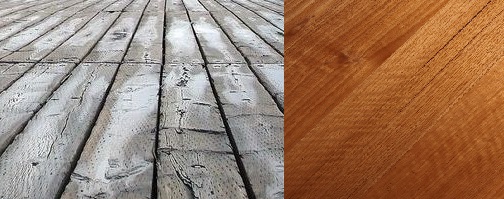
(left) Crude plank boardwalk, Quebec City, Canada (right) Finished mountain ash floor. (CC Past-SA 4.0; WikiPedant and CC Past-SA two.five; MarkAnthonyBoyle, respectively).
As you tin can encounter, the texture of the finished woods is much smoother than the initial grainy wood.
Color
The changing of color of a substance is non necessarily an indicator of a chemical change. For instance, irresolute the colour of a metallic does not change its concrete properties. However, in a chemical reaction, a color alter is usually an indicator that a reaction is occurring. Painting the metal machine does non changing the limerick of the metallic substance.
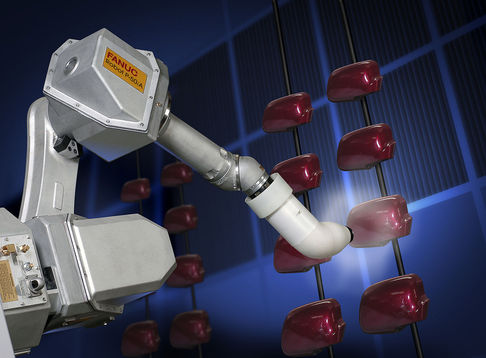
Robotic arm applying paint on car parts. Image utilise with permission (CC BY-SA four.0l RoboGuru).
Temperature
Although nosotros cannot see temperature modify, unless if a change of state is occurring, information technology is a concrete modify.

Hot metalwork. (CC BY-SA-NC two.0; flagstaffotos.com.au)
One cannot see the pan physically changing shape, color, texture, or any of the other physical properties. However, if one were to touch the pan, it would be incredibly hot and could cause a burn. Sitting idle in a cupboard, this pan would be cold. 1 cannot assess this modify only through visual exposure; the employ of a thermometer or other instrument is necessary.
Shape
The shape of an object can be inverse and the object will still remain true to its chemical composition. For example, if ane were to fold money, every bit shown past the figure beneath, the coin is still chemically the aforementioned.
Origami Money

Modify of State
The alter of land is likewise a physical change. In this scenario, one can detect a number of physical properties changing, such as viscosity and shape. Every bit ice turns into water, it does not retain a solid shape and now becomes a sticky fluid. The physical "reaction" for the change of ice into liquid water is:
\[H_2O_{(s)} \rightarrow H_2O_{(l)}\]

The following are the changes of state:
| Solid → Liquid | Melting |
| Liquid → Gas | Vaporization |
| Liquid → Solid | Freezing |
| Gas → Liquid | Condensation |
| Solid → Gas | Sublimation |
- If estrus is added to a substance, such every bit in melting, vaporization, and sublimation, the process is endothermic. In this case, estrus is increasing the speed of the molecules causing them move faster.
- If heat is removed from a substance, such as in freezing and condensation, then procedure is exothermic. In this instance, heat is decreasing the speed of the molecules causing them move slower.
Physical Properties
Luster
The luster of an chemical element is divers as the mode information technology reacts to light. Luster is a quality of a metallic. Almost all of the metals, transition metals, and metalloids are lustrous. The non-metals and gases are not lustrous. For example, oxygen and bromine are not lustrous. Shown below is are lustrous newspaper clips.
Lustrous Paperclips
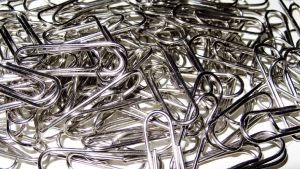
Malleability
Malleability is also a quality of metals. Metals are said to be malleable. This means that the metals can deform under an amount of stress. For case, if y'all tin hitting a metallic with a mallet and information technology deforms, information technology is malleable. Also, a paperclip can be shaped with bare hands.
Bent Paperclip
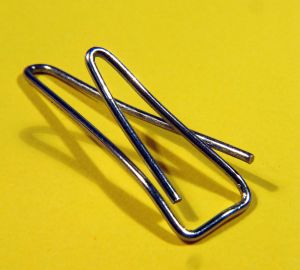
The paradigm shows the malleability of a certain metallic as stress is applied to it.
Ability to be drawn into a thin wire
In materials science, this property is chosen ductility. For example, raw copper can be obtained and it tin be purified and wrapped into a cord. Once once again, this property is characteristic of mainly metals, nonmetals do not possess this quality.
Copper Wire
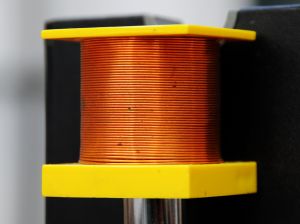
Density
The density of an object is its mass divided by its volume (d=grand/v). A substance volition accept a college density if information technology has more mass in a fixed amount of volume. For example, accept a ball of metal, roughly the size of a baseball game, compressed from raw metal. Compare this to a baseball fabricated of paper. The baseball made of metal has a much greater weight to information technology in the same corporeality of book. Therefore the baseball game made out of metallic has a much college density. The density of an object will besides determine whether it volition sink or bladder in a particular chemical. Water for instance has a density of 1g/cmthree. Whatsoever substance with a density lower than that will float, while whatsoever substance with a density in a higher place that volition sink.
Oil Sinking in a Glass of H2o

Viscosity
Viscosity is defined to be the resistance to deformation of a particular chemic substance when a strength is applied to it. In the example beneath, one can run into two cubes falling into two different test tubes. The upper substance shows a fierce reaction to the dropping of the cube. The lower substance only engulfs it slowly without much reaction. The upper substance has a lower viscosity relative to the lower substance, which has very high viscosity. Ane may even recollect of viscosity in terms of thickness. The substance with more thickness has college viscosity than a substance that is accounted "sparse." Water has a lower viscosity than honey or magma, which have relatively high viscosities.
Viscosity of Fluids

Mutual Chemical Changes
The follow are all indicators of chemical reactions. For farther data on chemical reactions, please refer to Chemic Reactions.
Change in Temperature
A modify in temperature is characteristic of a chemical change. During an experiment, one could dip a thermometer into a beaker or Erlenmeyer Flask to verify a temperature alter. If temperature increases, every bit it does in nigh reactions, a chemic change is likely to exist occurring. This is unlike from the physical temperature change. During a physical temperature alter, one substance, such as water is being heated. Even so, in this case, i compound is mixed in with another, and these reactants produce a product. When the reactants are mixed, the temperature alter caused past the reaction is an indicator of a chemical change.

Equally an example of a exothermic reaction, if \(Fe_2O_3\) is mixed with Al and ignighted (often with called-for Mg), so the thermite reaciton is initiated
\[Fe_2O_3 + 2Al \rightarrow 2Fe + Al_2O_3 + \text{Heat}\]
This reaction generates oestrus as a product and is (very) exothermic.
Even so, concrete changes can be exothermic or endothermic. The melting of an water ice cube, which is endothermic, is a change in a physical property and non limerick. Thus, it is a concrete change.
Modify in Color
A change in color is also another characteristic of a chemical reaction taking identify. For example, if one were to observe the rusting of metallic over time, one would realized that the metal has changed color and turned orange. This change in color is evidence of a chemical reaction. However, i must exist careful; sometimes a change in colour is just the mixing of two colors, merely no real change in the composition of the substances in question.
Metallic Rusting
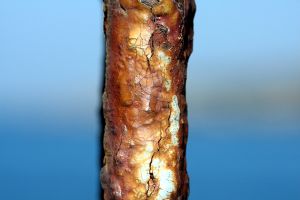
The reaction to a higher place is that of the rusting of iron.
\[4Fe + 3O_2 + 6H_2O \rightarrow 4Fe(OH)_3\]
Noticeable Scent
When ii or more compounds or elements are mixed and a olfactory property or aroma is present, a chemical reaction has taken place. For example, when an egg begins to olfactory property, (a rotten egg) a chemic reaction has taken place. This is the issue of a chemical decomposition.
Spoiled Egg
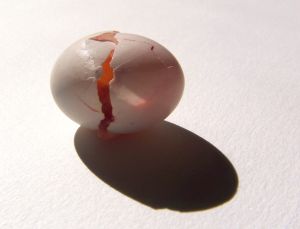
Formation of a Precipitate
The formation of a precipitate may be one of the most common signs of a chemical reaction taking place. A precipitate is defined to be a solid that forms inside of a solution or another solid. Precipitates should non be confused with suspensions, which are solutions that are homogeneous fluids with particles floating about in them. For instance, when a soluble carbonate reacts with Barium, a Barium Carbonate precipitate can be observed.
Test Tube

Reaction:
\[Ba^{two+}_{(aq)} + CO^{2-}_{3\;(aq)} \rightarrow BaCO){three\;(south)}\]
For further information, please refer to Nomenclature of Affair.
Formation of Bubbles
The germination of bubbles, or rather a gas, is another indicator of a chemical reaction taking place. When bubbles course, a temperature modify could also be taking place. Temperature modify and formation of bubbles often occur together. For example, in the following paradigm, 1 can meet a gas spewing. This is the formation of a gas.
Gas Formation

All the same, most reactions are much more subtle. For example, if the post-obit reaction occurs, one may notice Carbon Dioxide bubbling forming. If there is enough Hydrochloric acid, bubbles are visible. If in that location isn't, one can't readily notice the alter:
\[Na_2CO_3 + 2HCl \rightarrow 2NaCl + H_2O + CO_2\]
References
- Chang, Raymond. General Chemistry: the Essential Concepts. Boston, MA: McGraw-Hill Higher Education, 2006. Impress.
- Chemical science for Dummies. For Dummies, 2008. Print.
- Petrucci, Ralph H. General Chemical science Principles and Modernistic Applications. Upper Saddle River, NJ: Pearson/Prentice Hall, 2007. Print.
Outside Links
All images are courtesy of http://www.sxc.hu, which provides royalty free images that are free to be copied without restrictions. The viscosity epitome is besides free to be duplicated as per permission of author on Wikipedia.com.
Issues
1. Which of the following is a chemic reaction?
- Freezing liquid Mercury
- Adding yellowish to blue to make green
- Cutting a piece of paper into ii pieces
- Dropping a sliced orange into a vat of Sodium Hydroxide
- Filling a airship with natural air
two. Which of the following is a physical reaction?
- Shattering Glass with a baseball game
- Corroding Metal
- Fireworks Exploding
- Lighting a match
- Baking a cake
iii. Which of the following is a chemical reaction?
- Painting a wall blue
- A bike rusting
- Ice foam melting
- Scratching a primal across a desk
- Making a sand castle
4. Which of the post-obit is a physical reaction?
- Frying an egg
- Digesting carrots
- A Macbook falling out of a window
- Creating ATP in the human body
- Dropping a fizzy tablet into a glass of water
5. Write C for Chemical Reaction or P for Physical Reaction.
- Burning Leaves
- Cutting Diamonds
- Crushing a pencil
- The salivary amylase enzyme that breaks down food in the rima oris
- Table salt mixing in with water
Answers
1. D
2. A
3. B
four. C
five. a) C
b) P
c) P
d) C
eastward) Neither. This is one of the greyness areas of chemic modify and physical change. Although the salt has dissociated into Sodium and Chloride ions, it is however common salt in h2o. Salt, initially is really but a conglomerate of sodium and chloride ions and by dissociating them, just the arrangement of the ions has changed. Please click here for more than information.
Is Mixing A Chemical Change,
Source: https://chem.libretexts.org/Bookshelves/Physical_and_Theoretical_Chemistry_Textbook_Maps/Supplemental_Modules_(Physical_and_Theoretical_Chemistry)/Fundamentals/Chemical_Change_vs._Physical_Change
Posted by: mccuskermente1947.blogspot.com


0 Response to "Is Mixing A Chemical Change"
Post a Comment